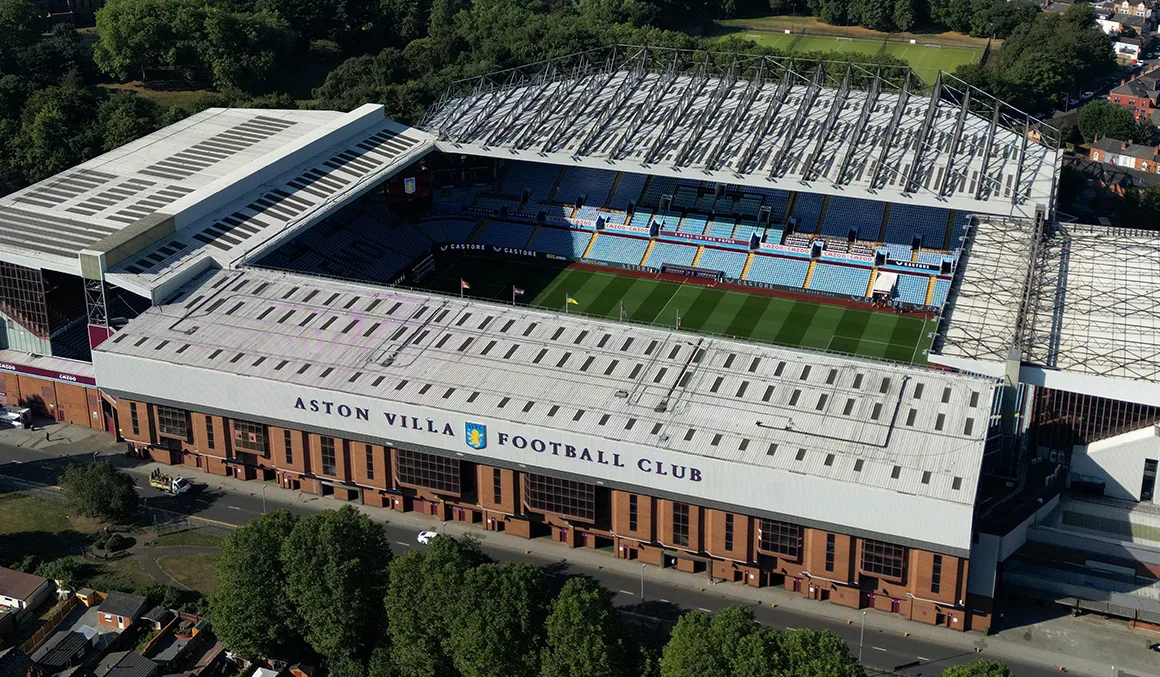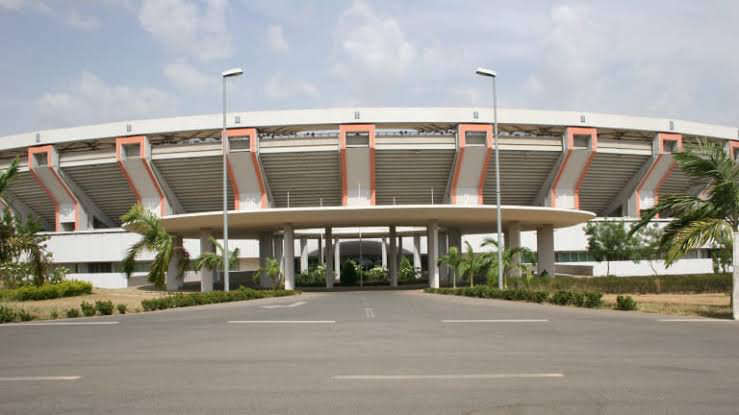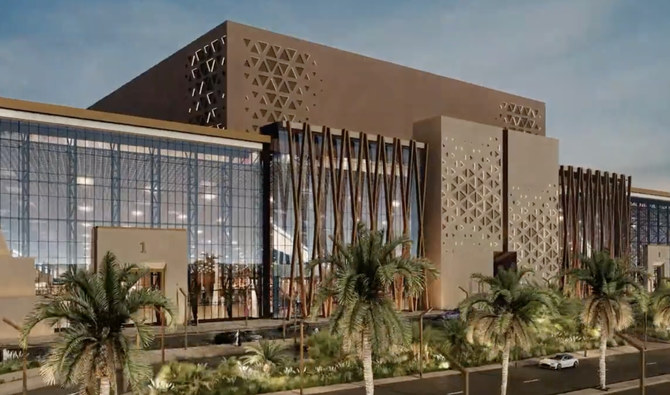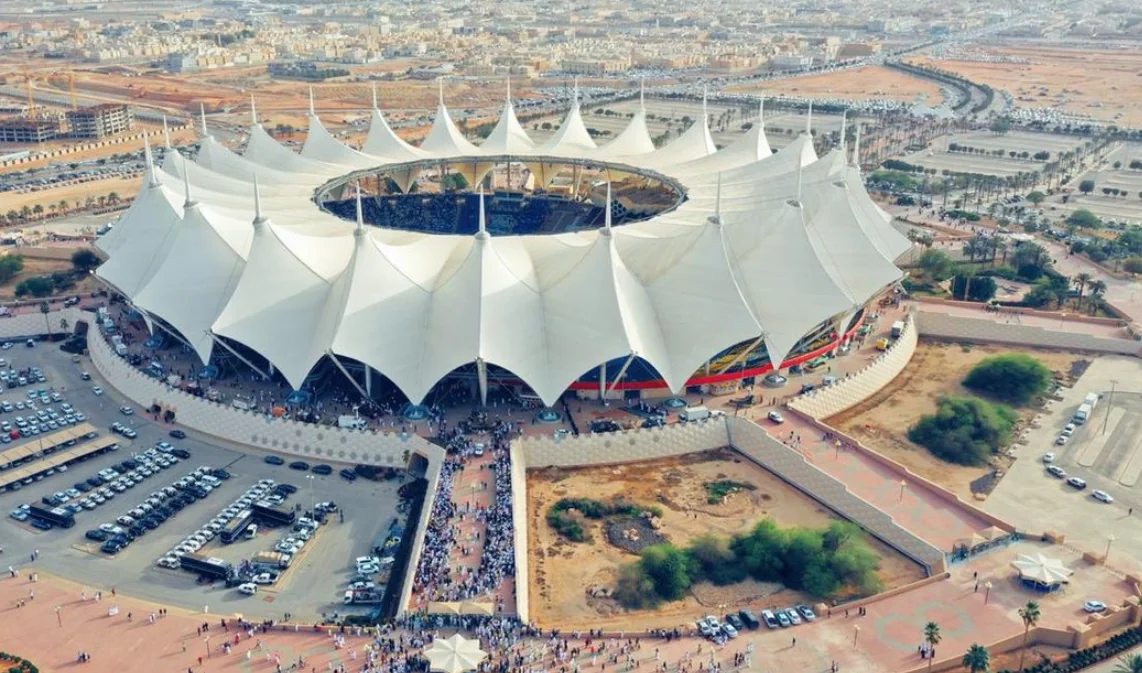Villa Park Stadium is a football stadium located in the Aston district of Birmingham, England. It has been the home of the Aston Villa Football Club since 1897 and has a seating capacity of 42,095. The stadium is less than a mile from both Witton and Aston railway stations and has hosted sixteen England internationals at senior level, the first in 1899 and the most recent in 2005.
The stadium has a rich history and has hosted 55 FA Cup semi-finals, more than any other stadium in England. It has also been used as a venue for other sports, including rugby union, boxing, and American football. In addition to sports events, Villa Park has also hosted numerous concerts and other events over the years, making it a versatile venue for a wide range of activities.
Key Takeaways
- Villa Park Stadium is a historic football stadium located in the Aston district of Birmingham, England.
- The stadium has hosted numerous high-profile sporting events and concerts over the years.
- With its versatile facilities and rich history, Villa Park Stadium is an important landmark in the local community and a popular destination for sports fans and music lovers alike.
villa park stadium History
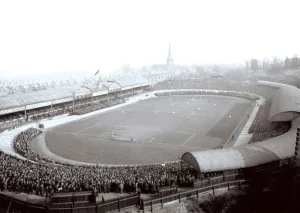
Construction and Opening
Villa Park is a football stadium located in Aston, Birmingham, England. It has been the home of Aston Villa Football Club since 1897 [1]. The construction of the stadium began in 1896 and was completed in just over six months. The stadium was officially opened on 17 April 1897, with a match between Aston Villa and Blackburn Rovers, which ended in a 3-1 victory for the home team. The stadium’s original capacity was 40,000, with a single tier stand on the Trinity Road side of the ground and a pavilion on the other three sides.
Renovations and Expansions
Over the years, Villa Park has undergone several renovations and expansions. In 1923, the stadium hosted the FA Cup final between Bolton Wanderers and West Ham United, which attracted a crowd of 126,047, the largest ever for an FA Cup final. As a result, the stadium was expanded to accommodate a capacity of 70,000 spectators [2].
In the 1950s, the stadium underwent another major renovation, which included the construction of the Holte End stand, which is now one of the most iconic stands in English football. The stand was named after William McGregor, the founder of the Football League, who lived in Holte Road, which runs behind the stand.
In the 1990s, the stadium underwent further renovations, which included the construction of the North Stand, which replaced the original Trinity Road Stand. The North Stand is the largest stand in the stadium and has a capacity of 13,500 spectators.
Historical Events
Villa Park has a rich history of hosting major football events. The stadium has hosted 16 England international matches, the first of which was played in 1899 and the most recent in 2005 [1]. The stadium has also hosted 55 FA Cup semi-finals, more than any other stadium in England [1].
In addition to football, Villa Park has also hosted other events, including concerts, boxing matches, and religious gatherings. In 1985, the stadium hosted a concert by the rock band Queen, which attracted a crowd of over 100,000 people. The concert was later released as a live album and video, titled “Live at Wembley ’86”.
Structure and Facilities
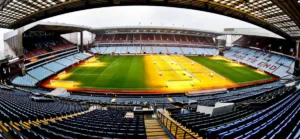
Villa Park is a football stadium located in Aston, Birmingham, and is the home ground of English Premier League club Aston Villa. The stadium has a seating capacity of 42,640, making it the 8th largest stadium in the league.
Seating Capacity
The stadium has been expanded and renovated several times over the years, with the most recent expansion in 2000, which increased the seating capacity from 39,500 to its current capacity. The stadium has four stands, namely the Holte End, the North Stand, the Doug Ellis Stand, and the Trinity Road Stand.
Pitch Details
The pitch at Villa Park measures 101m x 68m, which is the standard size for a Premier League pitch. The playing surface is natural grass, and the stadium has a state-of-the-art drainage system that ensures the pitch remains playable even in the worst weather conditions.
Stands and Terraces
The Holte End is the largest stand at Villa Park, with a capacity of over 13,000 fans. It is named after Sir William Holte, a 17th-century landowner, and is regarded as the heart and soul of the stadium. The North Stand is the second-largest stand, with a capacity of around 9,500 fans. The Doug Ellis Stand is located on the east side of the stadium and is named after the former chairman of Aston Villa. It has a capacity of around 7,000 fans.
The Trinity Road Stand is the smallest of the four stands, with a capacity of around 5,000 fans. It is located on the west side of the stadium and is named after the road that runs alongside it. The stand is known for its excellent views of the pitch and is popular with families and corporate clients.
Overall, Villa Park is a well-designed and well-maintained stadium that provides an excellent matchday experience for fans. With its impressive facilities and rich history, it is no wonder that Villa Park is regarded as one of the most iconic stadiums in English football.
villa park stadium Uses
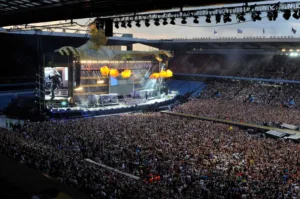
Villa Park stadium is a multi-purpose stadium located in Aston, Birmingham. It is mainly used for football matches, but it has also hosted several concerts and events. The stadium has a seating capacity of 42,640 and has been the home of Premier League club Aston Villa since 1897.
Club Home Matches
Villa Park is primarily used for hosting Aston Villa home matches. The stadium has been the home of Aston Villa since 1897. The ground has hosted numerous memorable matches, including the 1982 European Cup Final and the 2012 League Cup Semi-Final against Liverpool. The stadium has also hosted 55 FA Cup semi-finals, more than any other stadium in the country.
International Football
Villa Park has hosted 16 England internationals at senior level, the first in 1899 and the most recent in 2005. It has also hosted several other international matches, including the 1966 World Cup group match between Brazil and Bulgaria. The stadium is one of a select few that has staged international fixtures over three different centuries.
Concerts and Events
Aside from football matches, Villa Park has hosted several concerts and events. In 1988, Michael Jackson performed at the stadium as part of his Bad World Tour. Other notable artists who have performed at Villa Park include Bon Jovi, Bruce Springsteen, and Guns N’ Roses. In addition to concerts, the stadium has also hosted other events such as religious gatherings and corporate events.
Overall, Villa Park is a versatile stadium that has played an important role in the history of football and entertainment in the UK.
Location and Accessibility

Transport Links
Villa Park Stadium is located in the Aston area of Birmingham, England. The stadium is easily accessible by public transport, with two train stations within a mile of the stadium. Aston railway station is the closest, just a 10-minute walk away, while Witton railway station is also nearby.
In addition to the railway stations, there are several bus routes that run close to the stadium, making it easy for fans to get to and from the ground. The stadium is also located just off the A38(M) motorway, providing easy access for those travelling by car.
Parking Facilities
Parking at Villa Park Stadium is available on a matchday, although spaces are limited. Fans are advised to arrive early to secure a parking spot. There are also several car parks located near the stadium, including the Witton Arms car park, which is just a short walk away.
On non-matchdays, parking is available at the stadium, but fans are advised to use the Witton Road entrance and input the postcode B6 6QE into their satellite navigation system. This will ensure that they are directed to the correct entrance.
Local Amenities
There are several local amenities located near Villa Park Stadium, including a variety of restaurants, pubs, and shops. The stadium is located just a short distance from Birmingham city centre, which offers even more options for fans.
In addition to the local amenities, there are several hotels located near the stadium, making it easy for fans to stay overnight if they are travelling from out of town. Some of the closest hotels to the stadium include the Aston Conference Centre, the Aston Villa Hotel, and the Holiday Inn Express Birmingham – Star City.
Ownership and Management

Villa Park Stadium is owned by Aston Villa Football Club, which is a professional football club based in Birmingham, England. The club is owned by NSWE, a company jointly owned by Egyptian billionaire Nassef Sawiris and American billionaire Wes Edens. The duo took over the club in 2018 and have since invested heavily in the club’s infrastructure, including the redevelopment of Villa Park Stadium.
The day-to-day management of the stadium is overseen by the club’s Chief Operating Officer, who is responsible for ensuring that the stadium is maintained to a high standard and that all events held at the stadium run smoothly. The stadium also has a dedicated team of staff who are responsible for the upkeep of the stadium, including the pitch, seating areas, and facilities.
In addition to hosting Aston Villa’s home matches, Villa Park Stadium is also used for a range of other events, including concerts, corporate events, and private functions. The stadium has a range of facilities available for hire, including conference rooms, executive boxes, and hospitality suites. The stadium also has a number of food and beverage outlets, which are managed by the club’s catering team.
Overall, Villa Park Stadium is a well-managed and well-maintained facility that is a credit to its owners and management team. With ongoing investment in the stadium’s infrastructure, it is likely to remain one of the premier football stadiums in the UK for many years to come.
Fan Experience
Villa Park Stadium provides a unique fan experience that is hard to match. From the matchday atmosphere to the visitor services and safety and security, the stadium ensures that every fan has a memorable experience.
Matchday Atmosphere
The matchday atmosphere at Villa Park Stadium is electric. The home fans are passionate and create an intense atmosphere that is sure to get your heart racing. The stadium has a capacity of 42,000, and the fans are always in full voice, creating an unforgettable experience for all.
Visitor Services
Villa Park Stadium offers a wide range of visitor services to ensure that all fans have a comfortable and enjoyable experience. The stadium has a number of food and drink outlets, offering a variety of options to suit all tastes. The stadium also has a number of merchandise stores, where fans can purchase official Aston Villa merchandise.
Safety and Security
Safety and security is a top priority at Villa Park Stadium. The stadium has a comprehensive security system in place, including CCTV cameras, bag searches, and metal detectors. There are also trained stewards and security personnel on hand to ensure that all fans are safe and secure.
In summary, Villa Park Stadium provides a unique and unforgettable fan experience. The matchday atmosphere is electric, the visitor services are comprehensive, and safety and security is a top priority. Fans are sure to have a memorable experience at Villa Park Stadium.
Economic Impact
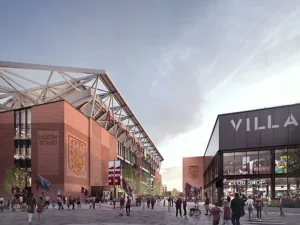
Local Economy
Villa Park Stadium has a significant impact on the local economy. According to a study by Aston University, the stadium generates approximately £58 million in economic activity per year, with £30 million of that being spent directly in the local area. The study also found that the stadium supports around 900 jobs, both directly and indirectly. This includes jobs in hospitality, retail, and transportation.
Furthermore, the stadium attracts visitors from outside the area, who spend money on accommodation, food, and other services. This helps to boost the local tourism industry and supports jobs in related sectors. The stadium also serves as a venue for conferences, exhibitions, and other events, which further contributes to the local economy.
Employment Opportunities
The construction of the new Villa Park Stadium is expected to create a significant number of jobs. According to the Birmingham Mail, the project is expected to create around 1,000 jobs during the construction phase. This includes jobs in construction, engineering, and other related fields.
Once the stadium is completed, it is expected to support around 900 jobs, both directly and indirectly. This includes jobs in hospitality, retail, and transportation. The stadium also provides opportunities for work experience and apprenticeships, which can help to develop skills and support career progression.
Overall, the economic impact of Villa Park Stadium is significant, both in terms of its contribution to the local economy and its support for employment opportunities.
Sustainability Initiatives
Villa Park stadium has made significant strides in recent years to become more sustainable and environmentally friendly. The club launched its “Claret, Blue, and Green” environmental sustainability commitment in 2021, which includes a range of initiatives to reduce the stadium’s carbon footprint.
One of the most significant changes to Villa Park’s infrastructure has been the installation of fully LED lighting for the stadium floodlights and other areas. This switch to LED lighting has resulted in a significant reduction in energy consumption and carbon emissions.
In addition to LED lighting, Villa Park has implemented a range of other energy-efficient measures. For example, the stadium has installed solar panels to generate renewable energy and has upgraded its heating and cooling systems to be more efficient.
Villa Park has also made strides in reducing waste and improving its waste management practices. The stadium has implemented a zero-waste policy and has been recognized by Green Business Certification Inc. as a zero waste facility. This achievement was a first for a venue of Villa Park’s size.
To further reduce waste, Villa Park has implemented a range of recycling initiatives, including the installation of recycling bins throughout the stadium. The club has also worked to reduce its water consumption by implementing water-efficient fixtures and fittings throughout the stadium.
Overall, Villa Park’s sustainability initiatives demonstrate the club’s commitment to reducing its environmental impact and becoming a more socially responsible organization.
Future Developments
Villa Park stadium has a bright future ahead with a series of exciting developments planned in the coming years. Here are some of the upcoming projects that fans can look forward to:
Stadium Expansion
The club has plans to expand the stadium’s capacity to over 50,000 spectators, making it one of the largest stadiums in the country. The first phase of the development is expected to be completed by 2025, with further expansion planned in the future. The expansion will include new seating areas, improved facilities, and state-of-the-art technology to enhance the fan experience.
Redevelopment of the North Stand
The North Stand, which is currently the oldest stand in the stadium, is set to undergo a major renovation. The project will see the stand rebuilt from scratch, with new facilities and amenities for fans. The redevelopment will also include the addition of new corporate boxes and hospitality areas, further enhancing the matchday experience.
Multi-Purpose Venue
The club has plans to create a multi-purpose venue at Villa Park, which will be used for a variety of events throughout the year. The venue will be designed to accommodate concerts, conferences, and other events, making it a hub for entertainment in the local area. The multi-purpose venue will also generate additional revenue for the club, helping to secure its financial future.
Overall, the future of Villa Park stadium looks bright, with a range of exciting developments planned in the coming years. The club’s commitment to improving the fan experience and creating a world-class sporting venue is sure to attract new fans and cement its position as one of the top football clubs in the country.
Frequently Asked Questions

What is the seating capacity of Villa Park Stadium?
Villa Park Stadium has a seating capacity of 42,749, making it one of the largest stadiums in the English Premier League.
How can I find a seating chart for Villa Park Stadium?
The seating chart for Villa Park Stadium can be found on the official Aston Villa Football Club website. The chart provides a detailed view of the stadium’s seating sections and stands.
What are the recent renovation updates for Villa Park?
Aston Villa Football Club has launched a pre-application planning consultation on the first phase of its long-term vision for Villa Park and the surrounding area. The plans will pave the way to create a world-class sporting venue, enabling the club to compete at the very highest level. The ambitious plans also set out the club’s commitment to celebrating its history and heritage, creating a multi-purpose and functional destination to support the whole community.
What is the postcode for Villa Park in Birmingham?
The postcode for Villa Park in Birmingham is B6 6HE.
What are the different sections and stands at Villa Park?
Villa Park Stadium has four main stands: the Holte End, the Trinity Road Stand, the Doug Ellis Stand, and the North Stand. Each stand offers different seating options and views of the pitch.
What are the payment options available at Villa Park?
Aston Villa Football Club accepts various payment options for tickets and merchandise purchases, including credit and debit cards, Apple Pay, and Google Pay. Cash is also accepted at certain locations within the stadium.
Other Stadiums Articles:
Check Out: St James’ Park Stadium: Home of Newcastle United Football Club
Check Out: The Amex Stadium: A Comprehensive Guide
Check Out: St Mary’s Stadium: Home of Southampton FC
Check Out: Cape Town Stadium: A Modern Icon in South Africa
Check Out: Dobsonville Stadium: A Comprehensive Guide to the Home of Soweto’s Football Giants
